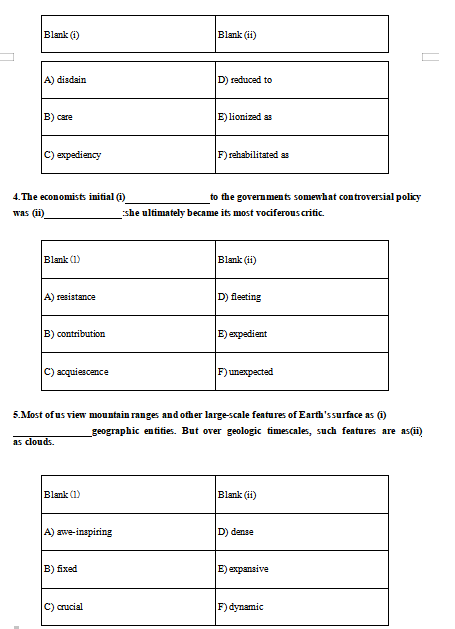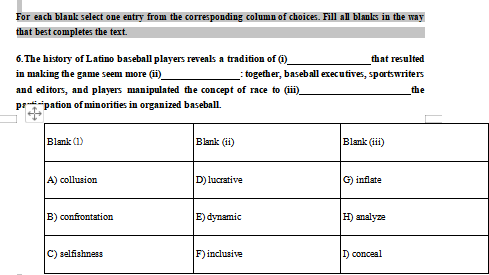
| 资料下载专区 | |||
| GRE模拟卷 | GRE官方指南 | GRE官方数学150题 | GRE数学词汇 |
导语:GRE考试倒计时中,各位同学准备充足了吗?经过新东方国际教育多位教师,精心研发推出的16套GRE考试模拟卷,祝你在最后的备考阶段一臂之力!完整版试卷合集请点击下载。更多GRE备考技巧分享请点击进入GRE数学、GRE写作、GRE填空、GRE阅读、GRE词汇、GRE试题等频道,新东方GRE考试网祝各位同学考试顺利!
Part 1 VERBAL REASONING
Select one entry for the blank. Fill the blank in the way that best completes the text.
1.One enhancement to artificial-intelligence-based virtual assistants involves their ability to pinpoint moments when human users make a request and then____________ : a new machine-learning algorithm allows the software to identify rescission.
A)reiterate
B)backtrack
C)give up
D)elaborate
E)hesitate
2.Until 2007, Japanese artist Kazuo Shiraga was____________ collectors in the United States; his current resurgence is helped by the vogue for so-called process-based abstraction and a revival of interest in performance art.
A)vastly overrated by
B)widely studied among
C)closely affiliated with
D)virtually unknown to
E)deliberately exoticized by
For each blank select one entry from the corresponding column of choices. Fill all blanks in the way that best completes the text.
3.A problem with the new collection of Tolson's work, ^Harlem Gallery" and Other Poems, is that while it treats his last book with (i)____________ , all the poems that came before seem left to fend for themselves,
(ii) ____________ “Other Poems.”
Select one answer choice.
In the late 1970s, bird populations were found to be declining in India's Bharatpur Bird Sanctuary in Rajasthan. Grazing cattle and buffalo were the suspected culprits: they were entering the preserve in sufficient numbers to disrupt what was believed to be an otherwise balanced ecosystem. Accordingly, grazing was banned in Bharatpur. Yet by the mid-1980s, studies found that bird diversity within the preserve had declined further since the ban, and it continued to plummet. The absence of grazing animals, it turns out, had disturbed the park's ecology. Weed species were taking over wetlands and choking canals, thereby reducing the fish populations that had once attracted so many birds, and avian species then went elsewhere in search of more suitable nesting places.
7.The passage suggests which of the following about the ufish populations"?
A)They were more diverse in the late 1970s than observers recognized at the time.
B)They were more adversely affected by the growth of vegetation after the ban on grazing than by avian predation.
C)They required a habitat that could not be sustained without measures to limit animal grazing.
D)They proliferated following changes to Bharatpur's ecosystem introduced by the ban on grazing.
E)They migrated to habitats that were inhospitable to grazing cattle and buffalo.
8.Which of the following statements, if true, would best explain the changes in “weed species"?
A)The species were not native to Bharatpur but spread rapidly once they were introduced.
B)The species had been kept in check by the large avian populations that once nested in Bharatpur.
C)The species were among the preferred forage plants grazed on by cattle and buffalo.
D)The species were necessary for maintaining suitable habitats for fish populations in Bharatpur's wetlands.
E)The species were unable to tolerate changing water conditions the canals of Bharatpur.
The positioning of Diane Arbus as a documentary photographer stems from the two exhibits that made her reputation, both curated by John Szarkowski: the group show New Documents in 1967 claimed to show documentary photography's new direction, which Szarkowski said aimed “not to reform life, but to know it”, and Diane Arbus, the posthumous one-woman show five years later, which turned her into an icon. Even as Szarkowski identified Arbus' work with the documentary tradition, both the American reformist line and the European taxonomic line represented by August Sanders (who came to be known in the United States in the 1960s), he also indicated the ways in which her work did not fit. If the documentary tradition displayed a consistent style of clarity and directness toward reality, it also displayed in the American tradition a particular emphasis on human suffering and a blend of realism and emotional charge, which was meant, in the words of Roy Stryker, the director of the Farm Security Administration, which sponsored the great documentary photography of the Depression era, to “incite change" by mobilizing sympathy. These two documentary modes—that of “knowing" and that of “reforming''—were tangling and untangling in the 1960s. For instance Walker Evans, who made his name with the Farm Security Administration in the 1930s, delivered his important lecture on Tyric documentary at Yale in 1964 in which he eschewed the social reform agenda; in 1966, the year before New Documents, the Farm Security Administration spirit had been revived by Cornell Capa's exhibition The Concerned Photographer, and its similarly titled catalog, and the documentary practices it celebrated made for some of the most arresting images and photo-essays of the Vietnam War.
That Arbus fulfilled the realist impulse of the documentary tradition could hardly be more obvious, whatever her subject matter. But documentary stuck to Arbus through the powerful intervention not only of Szarkowski but also of Susan Sontag, Arbus first and still most influential critic. Sontag's essay on the 1972 exhibit, which launched her inquiry into the medium of photography, is still routinely cited in reviews and scholarship on Arbus' work. Sontag framed the problem of Arbus's photographs within the documentary tradition following Szarkowski, and defined her work as a misappropriation of its form. Sontag claimed that Arbus photographed and collected other people's pain but offered no "'compassionate purpose” to the viewer. In these terms, Arbus lacked empathy and the photographs offered a "'self-willed test of hardness, one that inured the viewer to ugliness and pain. Sontag attached Arbus to one version of the documentary tradition, the US reformist agenda, and found Arbus' ability to mobilize sentiment not only deficient but also corrosive of sympathetic sensibilities more broadly.
9.The passage suggests that the photographs of August Sanders were
A)an important influence on Diane Arbus' work
B)likely viewed in Europe as misappropriating the documentary form
C)probably not familiar to most viewers of Arbus' work
D)included in exhibits that were curated by Szarkowski
E)not intended to elicit sympathy from viewers
10.According to the passage, which of the following is a way in which the American documentary tradition and European documentary tradition differed?
A)The American tradition encompassed a greater diversity of subjects than was typically found in the European tradition.
B)The European tradition drew on long-standing aesthetic precedents derived from other representational arts, whereas the American tradition did not.
C)The American tradition was meant to evoke an empathetic response in the viewer, whereas the European tradition was not.
D)Photographs in the European tradition displayed a more consistent clarity of style than those in the American tradition.
E)The American tradition was motivated by a greater realist impulse than the European tradition was.
11.The author of the passage mentions “Sontag's essay on the 1972 exhibit" primarily in order to
A)show how Arbus' work altered Sontag's view of documentary photography
B)suggest that Arbus' motivations were revealed in her selection of subjects
C)give evidence for the claim that Sontag is Arbus' harshest critic
D)illustrate how Sontag affected discussion surrounding Arbus’ work
E)support the idea that Arbus' work does not fit in any specific documentary tradition
12.The author of the passage would most likely agree with which of the following statements about Arbus' photographs?
A)They exemplified the contradictions inherent in the American tradition of documentary photography.
B)Their inclusion in Szarkowski's 1967 group show accounts for much of the attention received by that exhibition.
C)They adhered to the norms established by the European tradition of documentary photography in many ways.
D)They were representative of the practice of documentary photography in American in the 1960s.
E)They were an essential part of a larger global project to reform the practice of documentary photography.
Select the two answer choices that, when used to complete the sentence, fit the meaning of the sentence as a whole and produce complete sentences that are alike in meaning.
13.There are several strangein the book Indian for instance, though subtitled An Intimate Biography of 1.2 Billion People, it Hnds no place for the nearly 800 million Indians who depend on agriculture for a living.
A)elisions
B)omissions
C)censures
D)critiques
E)biases
F)digressions
14.Believing that Dr. Robert Walter Johnson's role in the development of tennis stars such as Arthur Ashe and Althea Gibson had often been___________ , his family worked for the last decade to raise Johnson's profile.
A)slighted
B)exaggerated
C)suppressed
D)minimized
E)hyperbolized
F)misinterpreted
15.Although Ogino Ginko's path to becoming Japan's first female physician in 1885the careers of doctors like Mary Edwards Walker, it is unclear whether Ginko knew about any American female physicians.
A)presaged
B)paralleled
C)inspired
D)resembled
E)impeded
F)exploited
16.A fixed definition of the Arctic Circle is: the circle is not unchanging but varies over about 2° during 40,000-year cycles caused by wobbles in the angle of the Earth's axis.
A)misleading
B)feasible
C)essential
D)possible
E)illusory
F)indispensable
Select one answer choice.
Partha's five-year-old embargo on the importation of fruit from Vallone was intended to keep a fungus from being accidentally brought into Partha. The fungus was nevertheless discovered to be present in Partha about a year ago. At about that time, it was also discovered in neighboring Morland. Clearly, what must have happened is that Vallonean fruit exporters circumvented the embargo by exporting fruit to Morland and then reexporting it from there to Partha.
17.Which of the following, if true, most seriously weakens the argument?
A)Morland's annual crop of fruit is just large enough to supply its own domestic market adequately.
B)The fungus colonies discovered in Partha and in Morland were of a distinct strain that has never been found to occur in Vallone.
C)The yields from Vallonean fruit crops have been well below normal in the last two years because of unexpected late frosts.
D)The fungus had been only a minor nuisance in Vallone until Vallone's Great Valley was converted, about ten years ago, in a major fruit-growing area.
E)Partha's embargo on Vallonean fruit was put in place after Parthan fruit growers had suffered losses because of accident imported insect pests.
The Isua rock formations in southwestern Greenland, which formed 3.8 to 3.7 billion years ago, include a variety of sedimentary rocks, which are records of erosion and deposition by surface water. Their testimony to abundant water at Earth's surface 3.8 billion years ago would seem to be at odds with models of stellar evolution, which predict that our Sun, a yellow dwarf star, would have been about 30% less luminous than it is today. With so much less incoming solar energy, any water on Earth should have been frozen. This is the faint young Sun paradox first recognized by astrophysicist Carl Sagan in 1972. Although there have been many creative proposals about how to reconcile this apparent contradiction between astrophysical theory and the rock record, the prevailing view is that an atmosphere dominated by greenhouse gases could have compensated for the dimmer Sun and made the early Earth's climate clement enough to keep ancient rivers rolling down to an open sea. Based on the atmosphere of neighboring Venus and Mars—the lingering breath of volcanoes---carbon dioxide (CO2) and water vapor are likely to have been the primary heat-trapping gases, although methane, ethane, nitrogen, ammonia, and other compounds may also have acted as additional blankets that kept the Archean world warm.
18.The passage is primarily concerned with
A)chronicling a long-standing debate within the scientific community
B)discussing new evidence that challenges a widely accepted scientific theory
C)presenting a possible explanation for an apparent scientific inconsistency
D)evaluating a possible explanation for an apparent scientific inconsistency
E)illustrating how a recent observation has sparked a new scientific debate
19.The reference to “erosion and deposition by surface water" serves to
A)underscore the extent of time required for the Isua rock formations to take shape
B)justify a contested date for the formation of certain geological features in Greenland
C)explain the process by which sedimentary and other classes of rocks are formed
D)emphasize that the formation of the Isua rocks was influenced more by subtractive processes than by additive ones
E)describe an empirical finding that supports a claim about surface temperatures on Earth 3.8 billion years ago
20.The author's assertion in the final sentence about “carbon dioxide (CO2) and water vapor" relies on which of the following assumptions?
A)The rates at which CO2 and water vapor were released into the atmosphere 3.8 billion years ago were comparable.
B)Methane and other compounds trap as much heat as CO2 and water vapor.
C)Volcanic activity is the exclusive sources of CO2 and water vapor in planetary atmospheres.
D)The composition of Earth's atmosphere 3.8 to 3.7 billion years ago was similar to that of its neighboring planets.
E)There are significant continuities between the Earth's present atmosphere and its atmosphere 3.8 to






